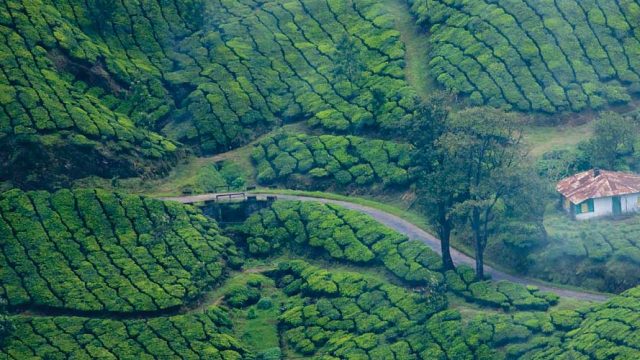Kerala is perhaps best known for the ports along its long coast. Traders, adventurers and conquerors followed the monsoon winds across the Indian Ocean to Kodungallur, Kannur, Kozhikode and Kochi, bringing with them new religions and cultures, creating a composite and diverse culture. But the trade and economy which made this region so attractive came from the rich offerings of its landlocked, mountainous regions. Thus, it is the Western Ghats, holding the monsoon clouds over Kerala and producing the spices initially and tea and coffee later, that attracted traders from afar, and shaped Kerala’s destiny.
The Western Ghats stretch across 1,600km from the southernmost tip of Gujarat to the southernmost tip of the Indian peninsula. They run along the western coast of the peninsula, parallel to the Konkan Coast in Maharashtra and Goa and the Malabar Coast in Karnataka and Kerala. The southern Western Ghats are the highest, the tallest peak being Anamudi, which falls in the Idukki District in Kerala.
These taller peaks contribute directly to Kerala’s monsoon-driven ecology. The mountains pin the monsoon clouds over the state during the rainy season from June to September, making districts such as Wayanad and Palakkad some of the most biodiverse and naturally rich parts of the world. The heavy monsoons also feed Kerala’s 41 river systems, including Bharatapuzha and Periyar. These rivers have not only provided fuel for the state but fired the imagination of poets alike, including the father of Malayalam literature, Thunchath Ezhuthachan. The evergreen forests and teeming wildlife, from Tholpetty to Thekkady, are also nurtured by the heavy rainfall. So rich is the monsoon’s bounty in these parts that the world’s second-highest rainfall was recorded at Lakkidi in Lower Wayanad, second to Cherrapunji, Meghalaya.

The unique conglomeration of climate and terrain has made this region an ecological hotspot, home to thousands of species of plants and animals, and extremely attractive to many migratory birds and insects. Prior to the arrival of the British, the Western Ghats were covered with dense forests, largely untouched by cultivation and settlement. From the mid-19th century onward, large chunks of forests were cleared for other purposes; the tea, coffee and teak produced in this area are known around the world. At the same time, increasing modernity offers a definitive threat to nearly 2,000 plant species, and a large number of mammals, birds and amphibians endemic to the region. Largely as a result of the efforts of the Save the Western Ghats March, the ecosystems in the area are preserved in two biosphere reserves, as well as a number of national parks and wildlife sanctuaries. The Government of India offers special protection for the “ecologically sensitive zone”, and has been strict about not permitting mining and hydroelectric projects in the region, thereby making sure the Western Ghats retain their serenity and charm. In 2012, UNESCO cleared nearly 40 wildlife sanctuaries, national parks and reserves in the region to be declared as World Heritage Sites.
Today, there are close to 10,000 elephants in the hills, some of whom are still free and can be found lunching on the plantations of India’s biggest tea companies. They are sometimes accompanied by the shy Nilgiri tahr, a wild goat that was driven almost to extinction till the Eravikulam National Park threw a protective cloak over its habitat. The tahr still flourishes in Chinnar and Periyar. Although poaching has endangered India’s tiny tiger population, these jungle cats roam freely in the Periyar Tiger Reserve. The landlocked districts of Idukki, Wayanad and Palghat offer diverse attractions for nature buffs and animal lovers: hill stations, wrapped more often than not in clouds, thick forests, wildlife reserves, trekking trails, waterfalls, sanctuaries as well as plantations. Idukki is best known for its tea plantations, while coffee produced in the Wayanad hills is consumed all over the world.

The Ghats are also laden with history. The altercations between Tipu Sultan and the British, who were harried by the former from Palakkad to Ponmudi, are well-known. The region is also home to stories of Kerala Varma Pazhassi Raja, known as the Lion of Kerala because of his martial exploits. One of the earliest freedom fighters in India, he resisted both the kingdom of Mysore, as well as British domination in the late 18th century. When the East India Company attempted to arrest him for organising a mass resistance against exorbitant taxation, he escaped using guerrilla warfare. He was captured and killed nine years later, having led the resistance for five years, in 1805. History enthusiasts would enjoy a visit to Sultan Bathery, where Tipu Sultan kept his canons, and the cave where Pazhassi Raja sought shelter while running from the law, both of which are close to one another, near Mangalore.
Tipu’s Fort at Palakkad stands sentinel over the pass that separates the forests of Silent Valley National Park and the tiger-haunted slopes of Parambikulam. Built by Haidar Ali, the fort offers a glimpse into the history of the Mysore Rajas. The pass is now coloured emerald with rice plantations, brightening up in post-harvest celebrations centered around the many temples and mosques. The site is also known for inspiring musicians such as Chembai Vishwanatha Bhagwathar, whose contribution to Carnatic music is unquestionable.




